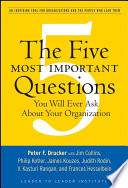

The first question focuses on the core purpose of an organization. Understanding and articulating the mission is crucial as it provides direction and motivation for all stakeholders. A well-defined mission statement serves as a guiding star for decision-making and helps align the efforts of employees, management, and the board. It fosters a sense of belonging and commitment among team members, ensuring that everyone is working towards a common goal. Organizations that frequently revisit and refine their mission are better equipped to adapt to changing environments and maintain relevance in their industries.
Continue readingIdentifying and understanding the target audience is vital for any organization. This question prompts leaders to think critically about their customers' needs, preferences, and behaviors. Knowing who the customers are allows organizations to tailor their products and services effectively, ensuring they meet market demands. Additionally, it helps in developing customer-centric strategies that enhance satisfaction and loyalty. Organizations that prioritize customer insights are often more innovative and responsive to market changes, leading to better overall performance.
Continue readingThis question delves into the specific needs and desires of customers. Understanding what customers value helps organizations create offerings that resonate with their target market. It goes beyond basic product features to encompass experiences, quality, and emotional connections. By actively seeking feedback and engaging with customers, organizations can gain valuable insights that inform product development and marketing strategies. Companies that prioritize customer value are more likely to succeed in building lasting relationships and achieving sustainable growth.
Continue readingAssessing organizational performance is crucial for continuous improvement. This question encourages leaders to evaluate outcomes against established goals and objectives. By measuring results, organizations can identify strengths and weaknesses, enabling them to make informed decisions about future strategies. Key performance indicators (KPIs) and metrics play a significant role in this process, providing quantifiable data that guide performance assessments. Organizations that regularly review their results are better positioned to pivot and adapt to challenges, ensuring long-term success.
Continue readingHaving a clear, actionable plan is essential for translating vision into reality. This question prompts organizations to outline strategic initiatives and allocate resources effectively. A well-structured plan includes short-term and long-term goals, timelines, and responsibilities. It serves as a roadmap that guides decision-making and prioritization. Organizations that invest time in planning are more likely to anticipate challenges and seize opportunities, fostering a proactive culture that drives innovation and growth.
Continue readingReflection is a critical component of organizational growth. This idea emphasizes the need for organizations to regularly assess their strategies and outcomes, learning from both successes and failures. Adaptation is equally important, as it allows organizations to respond to changes in the market and evolving customer needs. By fostering a culture of reflection and adaptation, organizations can enhance their resilience and agility, ensuring they remain competitive in a rapidly changing landscape. This iterative process of learning and adapting is vital for long-term sustainability.
Continue readingThe final key idea revolves around the importance of engaging all stakeholders in the organizational process. This includes employees, customers, suppliers, and the community. Engaging stakeholders fosters a sense of ownership and accountability, leading to improved collaboration and innovation. Organizations that prioritize stakeholder engagement are better equipped to gather diverse perspectives, which can inform decision-making and enhance overall performance. Building strong relationships with stakeholders ultimately contributes to a more resilient and successful organization.
Continue reading